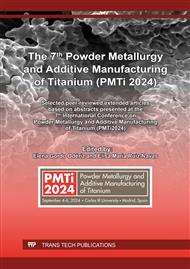p.41
p.49
p.57
p.65
p.73
p.83
p.93
p.103
p.113
Comparing Lithography-Based Metal Manufacturing for Titanium with Established Processes such as Cold Metal Fusion
Abstract:
This study delves into the nuanced challenges of additive manufacturing, specifically focusing on the application of sinter-based processes for reactive materials, with Titanium as the focal point. The thermal debinding and sintering processes, crucial steps in shaping, are analyzed with an emphasis on the intricate control required for the removal of polymeric binders, especially concerning the reactivity of metals during these processes. Historically, the emphasis has been on materials like 316L and 17-4-PH due to their straightforward thermal debinding and sintering processes. However, the shift to Titanium and its alloys introduces complexities, requiring special debinding and meticulous control of interstitial elements such as C and O to adhere to stringent material standards such as ASTM F2885-17. This research examines the various stages of shaping progressions, addressing specific requirements like green part strength, flexibility (filaments), flowability (Metal Injection Molding), and crosslinking (Stereolithography). The focus lies on achieving thermal removal with minimal residuals and reactivity, particularly in the context of reactive metals. Lithography-Based Metal Manufacturing (LMM) and Cold Metal Fusion (CMF) emerge as significant additive manufacturing processes for small to medium-sized batches of titanium parts, utilizing sinter-based production setups. Both processes not only serve as alternatives to Metal Injection Molding but also contribute to cost-effectiveness and sustainability through the efficient reuse of unused feedstock. The selection of the optimal shaping technology for individual parts becomes critical, considering mechanical properties, final density, acceptance of interstitials, complexity, wall thickness, overhangs, and internal structures. This presentation provides a detailed analysis of Lithography-Based Metal Manufacturing, comparing it with the Cold Metal Fusion process. Key considerations include mechanical properties, surface finishes, and cost, shedding light on the technical intricacies and trade-offs inherent in each technology.
Info:
Periodical:
Pages:
113-120
Citation:
Online since:
March 2025
Authors:
Price:
Сopyright:
© 2025 Trans Tech Publications Ltd. All Rights Reserved
Share:
Citation:



